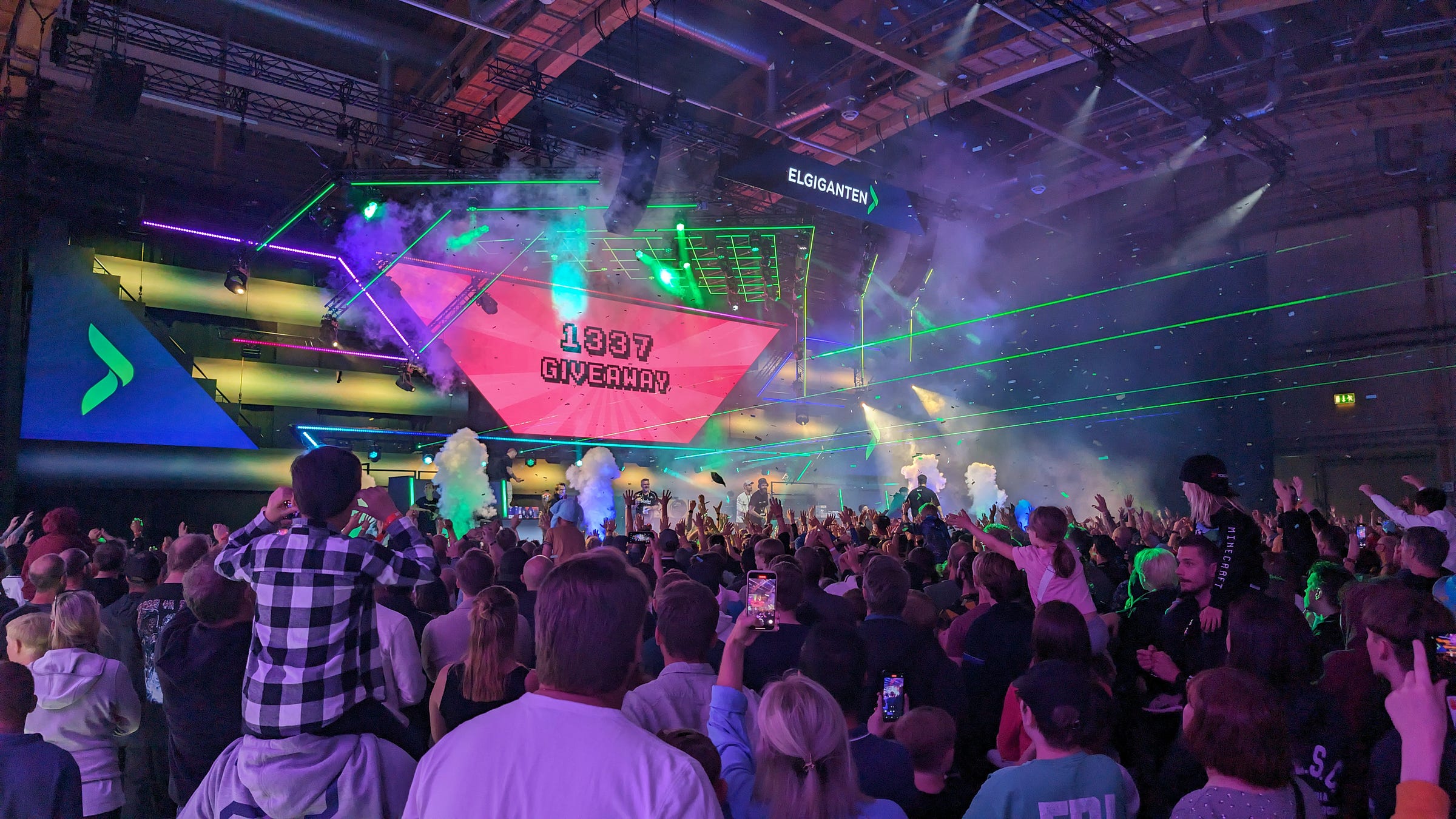DreamHack 25 Years Later: A Case Study in Camus’ Replacism
I traveled to Jönköping and was reminded of how authentic grassroots movements have been sacrificed on the altar of commercialism. Does it have to be this way?
Last summer, I attended Dreamhack Summer in Jönköping with my 10-year-old son. It was, of course, for his sake that we went, but I have to admit I was a little curious to see how the event had evolved since I last attended back in 1999. I knew it would be different, of course, but what I encountered was a completely different beast. At the same time, the transformation seemed like such a clear parallel to broader societal changes that I couldn’t stop thinking about it throughout the evening.
In this transformation, I see a microcosm of a broader societal trend—one where passion and community give way to commercialization and consumerism. What does Dreamhack’s evolution tell us about society at large? And why does it remind me so much of the development of Swedish football? Could it be that Renaud Camus—the French philosopher known for his writings on the Great Replacement—might help us understand this too?
Dreamhack as a Demo Party
Dreamhack began in 1994 as a demo party in the small town of Malung, Sweden, later moving to Arena Kupolen in Borlänge. That’s where I attended in 1998 and 1999. Eventually, the event relocated to Elmia in Jönköping and the Stockholm Exhibition Center. But the real difference isn’t the venue—it’s the content. Dreamhack was originally a demo party, a gathering place for tech nerds competing in programming, music, and art. We thrived on the challenges presented by both modern and vintage computers, constantly trying to push the limits and prove who could create the most with the least.
One notable example is the winning entry in the four-channel music competition, “Logdans” by the artist d00m. As the name suggests, the competition restricted participants to four audio channels and a very limited memory for storing sounds. Creating something that sounded good under such constraints required immense skill and creativity—that was the fun of it!
The winner of the same year’s pixel art competition was “Fantasy Dolfin” by DarkOne.
But the real highlight of the event was the demo competitions, where creators showcased what they could achieve through programming. The challenges were further elevated by different classes with unique restrictions and platforms. The winner of the PC category that year was “Off” by the Finnish group Doomsday.
The demo scene was nerdy, unapologetically unpolished, wildly creative, and likely incomprehensible to outsiders. But it had soul. It was a grassroots movement that thrived on community and passion.
Hypercommercialization and Unreachable Stars
As Dreamhack grew, it gradually shifted focus—from grassroots creativity to a spectacle driven by sponsors, big budgets, and global recognition. Fast forward 25 years, and Dreamhack is no longer a demo party—not even as a niche component. It’s now a full-blown gaming festival, drenched in hyper commercialization. Everyone wants to be part of it: the military, the police, unions, recycling campaigns, and, of course, the major tech and gaming companies. It’s a sprawling exhibition with flashing lights and pounding music, each booth trying to sell you a product, service, or government initiative.
This mirrors a broader trend in cultural events across the globe, where grassroots creativity often gives way to corporate interests. Whether it’s music festivals, art expos, or even traditional fairs, the focus increasingly shifts from fostering community to maximizing sponsorships and revenue streams. Dreamhack is a prime example of how these dynamics play out, prioritizing spectacle and profit over the authentic experiences that once defined such gatherings.
On stage, you no longer see programming, music, or art. Instead, it’s all about esports tournaments. Star players hold “meet and greets,” while streamers sit in a row like caged attractions, with fans watching them broadcast their gameplay live.
Change is inevitable, sure. But what’s changed here is the very soul of the event. What was once a grassroots movement fueled by passion and creativity has become a spectacle of consumerism and surface-level appeal. Gaming competitions with multi-million-dollar prize pools, “stars” showcasing themselves, and countless companies vying for your attention—it’s a far cry from what it once was.
A Parallel with Swedish Football
The transformation of Dreamhack reminds me of another evolution: the culture of Swedish football fans. Both examples highlight how grassroots culture, once driven by passion and community, has been overtaken by commercialization and corporate influence, leaving behind a focus on profit and spectacle. The transformation of Swedish football from the 1990s to today is staggering. Beyond the rules of the game itself, almost nothing is the same.
The money involved is enormous, and the players are now celebrities. In the 1990s, Hammarby’s goalkeeper, Per Fahlström, worked as a local police officer in the same neighborhood where I grew up. Today, Hammarby’s goalkeeper, Warner Hahn, has been a full-time professional for his whole life.
Players come and go like mercenaries, and the local connection of teams grows weaker. Many matches have moved from traditional stadiums like Söderstadion or Stockholms Stadion to spaceship-like arenas with names like Tele2 Arena, Platinum Cars Arena, or my favorite: Falcon Alkoholfri Arena (“Falcon Non-Alcoholic Arena”).
Tickets have become prohibitively expensive. For example, in the past, children who participated in local youth football leagues in Stockholm were given free access to countless Allsvenskan matches as part of a community initiative. Today, however, even attending a single match can be a financial strain for many working-class families.
Here too, the soul has been altered, or even stolen. What was once genuine and rooted in the community has been replaced by hyper commercialization. The bond between players and fans has eroded, replaced by idolatry and celebrity worship.
Renaud Camus and the Theory of Replacement
As I reflected on these changes, I couldn’t help but think of Renaud Camus, who wrote about the “tendency to replace everything with its normalized, standardized, interchangeable copy: the original with its replica, the authentic with its imitation, the true with the false…”
Isn’t that exactly what we’re seeing with Dreamhack and Swedish football? At Dreamhack, attendees are no longer active participants contributing to the event’s creativity and culture. Instead, they’re treated primarily as consumers, bombarded with advertisements and encouraged to spend. Similarly, in Swedish football, fans are no longer part of a community tied to local teams but are instead paying customers idolizing distant celebrities.
There’s something new here that young people today probably enjoy, but it’s an imitation of what once was. The participants in the stands or exhibition halls are now seen primarily as consumers, not as part of a movement.
Where Can We Find Authenticity Today?
Where, then, can we find the authentic today? The places untouched by commercial forces?
I honestly don’t know. But as I watched my son take in Dreamhack 2024, I couldn’t help but wonder how he will look back on it in 25 years. Will he remember the flashing lights, the esports stars, and the endless booths as a vibrant celebration of gaming culture? Or will he, like me, feel the pang of something lost—a sense of community, creativity, and authenticity that has been replaced by consumerism? Perhaps he will reflect on how the event evolved further, or maybe he’ll be part of a countermovement reclaiming the spirit of the original Dreamhack. Only time will tell.
History has shown us that authenticity has a way of resurfacing when people tire of imitation. Whether in gaming, sports, or other cultural arenas, I hope we’ll see a revival of the passion and creativity that once defined these spaces. I miss it deeply. But I hold onto the belief that, eventually, a countermovement will emerge.
Anything less would mean the death of culture itself.




